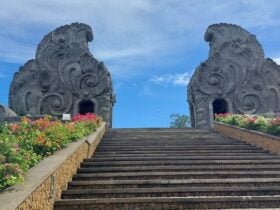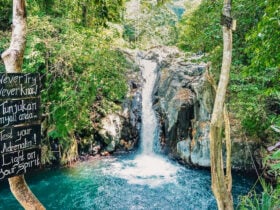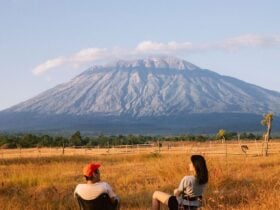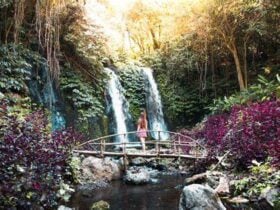Trunyan Village Kintamani

Trunyan Village Kintamani: Unveiling the Mysteries of Bali’s Ancient Burial Site


Trunyan Village Kintamani, nestled along the eastern shore of Lake Batur in Kintamani, Bali, is a destination that offers a glimpse into the island’s most ancient and mysterious traditions. Known for its unique burial customs and the ancient Bali Aga culture, Trunyan is a place where time seems to stand still, allowing visitors to step back into Bali’s past. This article will explore Trunyan Village, from its location and history to the activities available for visitors, the costs involved, and how to get there.
If you visit Trunyan Village, here’s what you need to know :
- Trunyan Village Location
- History about Trunyan Village Kintamani
- Things you can do at Trunyan Village
- What things can’t do at Trunyan Village
- Ticket Price go to Trunyan Village
- How to get to Terunyan Village
1. Trunyan Village Location

Trunyan Village is located in the Kintamani district of Bangli Regency, on the northeastern side of Bali. The village is situated on the eastern shore of Lake Batur, one of Bali’s largest volcanic lakes, which lies at the foot of Mount Batur, an active volcano. The village’s location is both remote and scenic, offering stunning views of the lake, the surrounding volcanic landscape, and the lush green hills that encircle the area.
Trunyan is accessible only by boat, which adds to its sense of isolation and mystique. The nearest road-accessible village is Kedisan, located on the western shore of Lake Batur. From Kedisan, visitors must take a boat across the lake to reach Trunyan, a journey that is as much a part of the experience as the destination itself.
The village’s seclusion has helped preserve its ancient traditions and customs, making it one of the last bastions of the original Bali Aga culture. This isolation also means that Trunyan has escaped much of the modernization that has affected other parts of Bali, offering a rare glimpse into the island’s past.
2. History of Trunyan Village, Kintamani

Trunyan Village is one of the oldest and most culturally significant villages in Bali. The village is home to the Bali Aga people, the island’s original inhabitants, who have lived in this area for over a thousand years. The Bali Aga, often referred to as “mountain Balinese,” are known for their adherence to pre-Hindu traditions and their resistance to outside influences, including those from the Majapahit Kingdom, which spread Hinduism throughout Bali in the 14th century.
The name “Trunyan” is derived from “Taru Menyan,” which translates to “the fragrant tree” in the ancient Balinese language. This name is linked to the large, sacred banyan tree known as the Taru Menyan tree, which plays a central role in the village’s burial practices. According to local legend, the scent of this tree is so potent that it neutralizes the smell of decomposing bodies, allowing the villagers to leave their dead exposed in bamboo cages.
This burial practice, known as Mepasah, is one of the most distinctive aspects of Trunyan’s culture. Unlike most Balinese, who practice cremation, the people of Trunyan leave the bodies of the deceased under the Taru Menyan tree to decompose naturally. The bones are then collected and placed in a nearby ossuary. This practice is reserved for those who die of natural causes, and it reflects the village’s deep connection to its ancestral traditions.
Trunyan’s history is also closely linked to the mystical and spiritual beliefs of the Bali Aga people. The villagers believe that the Taru Menyan tree is a sacred gift from the gods, and it is treated with the utmost respect. The village itself is considered a holy place, and visitors are expected to behave respectfully and follow local customs.
3. Things You Can Do at Trunyan Village

A visit to Trunyan Village is a unique cultural experience that offers a rare insight into Bali’s ancient traditions. Here are some of the key activities and sights that you can enjoy during your visit:
- Visit the Trunyan Cemetery (Sema Wayah): The most famous attraction in Trunyan is the cemetery, where the village’s unique burial practices take place. The cemetery is located on the edge of Lake Batur, a short distance from the main village. Here, you can see the bamboo cages where the bodies are placed, as well as the Taru Menyan tree, which is believed to neutralize the smell of decay. The cemetery is a solemn and sacred place, offering a powerful insight into the spiritual beliefs of the Bali Aga people.
- Explore Traditional Bali Aga Architecture: The houses in Trunyan Village are built in the traditional Bali Aga style, using natural materials such as bamboo, wood, and thatch. The village layout is also traditional, with homes arranged in a way that reflects the ancient customs and social structure of the Bali Aga people. Walking through the village, you’ll get a sense of how the Bali Aga have lived for centuries, largely untouched by outside influences.
- Learn About Local Customs and Traditions: Trunyan Village is one of the few places in Bali where you can witness the ancient customs of the Bali Aga people firsthand. The villagers continue to practice their traditional rituals, ceremonies, and way of life, providing visitors with a rare opportunity to learn about Bali’s pre-Hindu culture. Engaging with the locals and participating in village activities can deepen your understanding of these unique traditions.
- Enjoy the Scenic Beauty of Lake Batur: The journey to Trunyan Village by boat offers breathtaking views of Lake Batur and the surrounding volcanic landscape. The lake is often calm and mirror-like, reflecting the dramatic peaks of Mount Batur and the lush forests that line its shores. The boat ride is a peaceful and scenic experience that enhances the overall visit to Trunyan.
- Participate in Cultural Ceremonies: If you visit Trunyan during a religious or cultural event, you may have the opportunity to witness or participate in the village’s ceremonies. These ceremonies, which are held to honor the ancestors, seek blessings, and celebrate important life events, are deeply rooted in the Bali Aga’s spiritual beliefs. Observing these rituals provides a deeper connection to the village’s culture and history.
3. What Things You Cannot Do in Trunyan Village?

1. Do Not Disrespect the Burial Site: The Trunyan Cemetery is a sacred place, and it is crucial that visitors show the utmost respect when visiting. This means refraining from making loud noises, touching the bodies or burial structures, and taking photos without permission. It’s also important to avoid any behavior that could be seen as disrespectful, such as pointing your feet at the graves or walking over them.
2. Do Not Disturb the Villagers: The people of Trunyan are deeply connected to their traditions and way of life. Visitors should be mindful not to disturb the villagers by intruding on their homes, taking photos without permission, or behaving in a way that disrupts their daily routines. It’s important to remember that Trunyan is not just a tourist destination but a living community.
3. Do Not Bring Unapproved Items into the Village: Certain items, particularly those associated with modern or Western cultures, may not be appropriate to bring into Trunyan. This includes items like alcohol, tobacco, or non-traditional clothing. Visitors should also avoid bringing plastic waste into the village, as the community is committed to preserving their environment and minimizing pollution.
4. Do Not Enter Sacred Areas Without Permission: Certain areas of the village, such as temples or sacred sites, may be off-limits to visitors or require special permission to enter. It’s important to respect these boundaries and not enter any area without first obtaining permission from a local guide or village authority. If you are allowed to enter a sacred area, be sure to follow all instructions regarding behavior, dress code, and photography.
5. Do Not Offer or Expect Modern Amenities: Trunyan Village has intentionally preserved its traditional way of life, which means that modern amenities such as Wi-Fi, restaurants, or entertainment facilities are not available. Visitors should not expect or demand these conveniences and should be prepared for a more rustic and authentic experience. It’s also important not to offer modern conveniences, such as electronic devices or packaged foods, to the villagers, as this can disrupt their way of life.
6. Do Not Negotiate Aggressively: While it’s common to negotiate prices for services like boat rides or guiding in Bali, it’s important to do so respectfully in Trunyan. Aggressive bargaining can be seen as disrespectful and can create tension with the local community. It’s best to agree on a fair price beforehand and to keep in mind that the fees you pay contribute to the preservation of the village and the well-being of its inhabitants.
4. Tips for a Respectful Experience go to Trunyan Village

Visiting Trunyan Village can be a profound and enlightening experience, but it requires a mindful approach. Here are some tips to help you navigate your visit respectfully:
- Dress Modestly: Wear clothing that covers your shoulders and knees, especially when visiting sacred sites or interacting with the villagers. Modest dress is a sign of respect for the local culture and traditions.
- Follow Your Guide’s Instructions: Your local guide is your best resource for understanding the dos and don’ts in Trunyan. Listen carefully to their instructions and ask questions if you’re unsure about anything.
- Be Mindful of Your Surroundings: Pay attention to the behavior of the villagers and follow their lead. If you’re unsure whether something is appropriate, it’s always better to ask your guide or a local authority.
- Respect the Sacred Nature of the Village: Remember that Trunyan is not just a tourist destination but a place of deep spiritual significance. Approach your visit with humility and respect, and be mindful of the impact your presence may have on the community.
5. Ticket Price Trunyan Village

Visiting Trunyan Village involves several costs, primarily related to transportation and entry fees. Here’s a breakdown of the main expenses:
- Boat Ride: The boat ride from Kedisan to Trunyan Village is a mandatory part of the journey, as the village is only accessible by water. The cost of the boat ride typically ranges from IDR 300,000 to IDR 600,000 (approximately USD 20 to USD 40), depending on the number of passengers and the type of boat. It’s advisable to negotiate the price beforehand and ensure that the fee includes a round trip.
- Entrance Fee: As of 2024, the entrance fee to Trunyan Cemetery is around IDR 100,000 per person (approximately USD 7). This fee is collected by the village authorities and is used to maintain the cemetery and support the local community. There is no separate entrance fee for visiting the village itself, but donations are appreciated if you visit any of the local temples or participate in ceremonies.
- Guide Fee (Optional): Hiring a local guide is highly recommended, especially if you want to learn more about the village’s history and customs. The cost of a guide typically ranges from IDR 100,000 to IDR 200,000 (approximately USD 7 to USD 14), depending on the duration and depth of the tour. A guide can also help facilitate interactions with the villagers and ensure that you follow local customs.
6. How to Get to Trunyan Village?

Getting to Trunyan Village requires a bit of planning, as the village is located in a remote area of Bali and is accessible only by boat. Here’s a step-by-step guide on how to reach Trunyan:
- From Denpasar or Ubud: The journey to Trunyan usually begins in Denpasar or Ubud. From either of these locations, you can hire a car or motorbike to drive to Kedisan Village, which is located on the western shore of Lake Batur. The drive takes about 2 to 3 hours from Denpasar or about 1.5 to 2 hours from Ubud, depending on traffic.
- To Kedisan Village: Once you arrive in Kedisan, you will need to arrange for a boat to take you across Lake Batur to Trunyan Village. Boat services are available at the Kedisan pier, and you can either book a boat in advance through a tour operator or negotiate with local boatmen at the pier.
- Boat Ride Across Lake Batur: The boat ride from Kedisan to Trunyan takes approximately 20 to 30 minutes. The boats used for this journey are typically small, traditional Balinese outrigger canoes, which can accommodate a few passengers. The ride offers stunning views of Lake Batur, Mount Batur, and the surrounding landscape, making it a highlight of the trip.
- Arriving at Trunyan Village: Upon arrival at Trunyan, you will disembark at a small pier near the village. From there, it’s a short walk to the village center and the cemetery. Be sure to follow your guide’s instructions and respect the local customs as you explore this unique and sacred place.
Conclusion
Trunyan Village in Kintamani is one of Bali’s most enigmatic and culturally rich destinations. Its remote location, unique burial customs, and well-preserved Bali Aga culture make it a must-visit for those interested in exploring the island’s ancient traditions. By understanding the history, costs, and logistics of visiting Trunyan, you can fully appreciate the significance of this remarkable village and the deep spiritual connection its people have maintained with their ancestral heritage.










Leave a Review